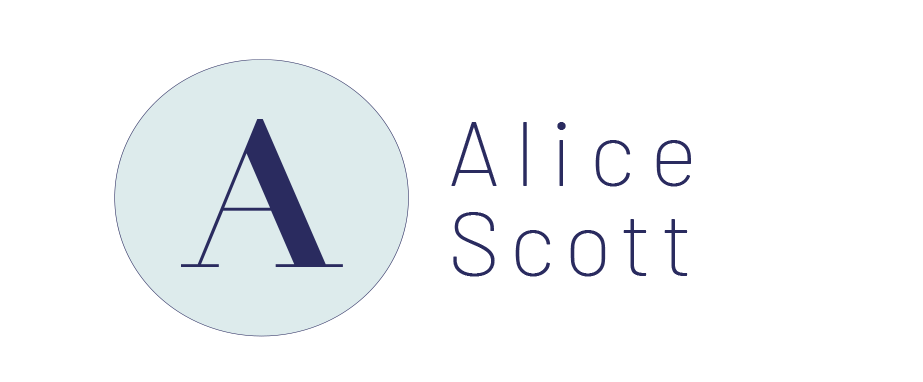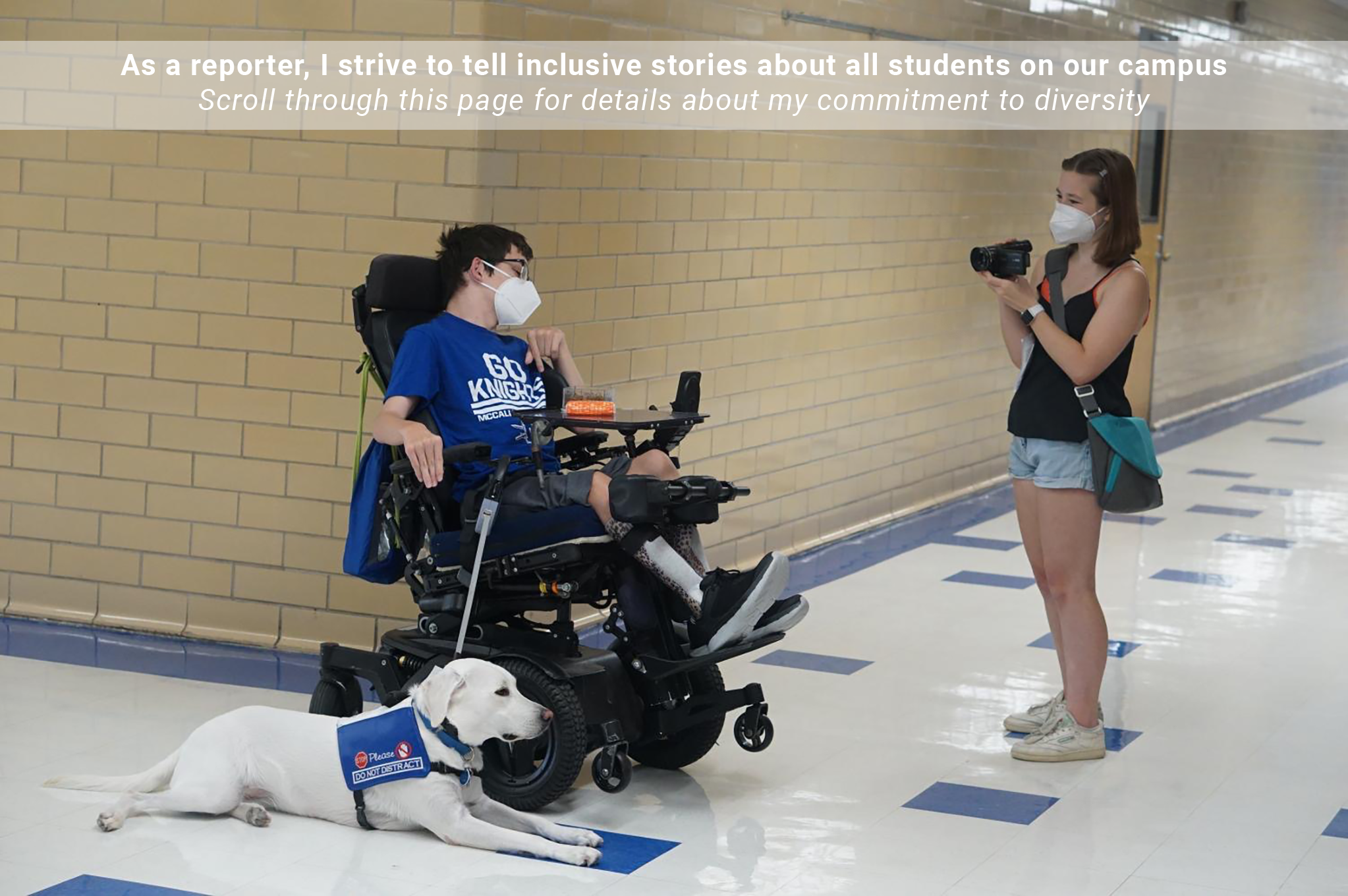INTRODUCTION
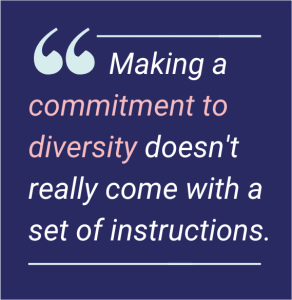 It can be easy to think that diversity is just about representing marginalized groups or individuals. But really, issues surrounding diversity and inclusiveness affect everyone on campus. And it is the role of student journalists to authentically capture all members of the school community, making it irresponsible to fail in creating a diverse and inclusive publication.
It can be easy to think that diversity is just about representing marginalized groups or individuals. But really, issues surrounding diversity and inclusiveness affect everyone on campus. And it is the role of student journalists to authentically capture all members of the school community, making it irresponsible to fail in creating a diverse and inclusive publication.
However, one of the most challenging aspects of being a staff leader is that making a commitment to diversity doesn’t really come with a set of instructions.
In my time on staff, I have looked at a number of ways to ensure that all voices on campus are being represented in our publication. It hasn’t been easy. But by looking more closely at audience, storytelling, coverage and engagement, I have found creative solutions to a complex responsibility of student publications.
work samples
Audience
In order to be successful, all publications must consider their audience. Usually, this involves considering their interests or their reading style. However, responsible journalism is about so much more than that. It is about telling stories that don’t just engage an audience but correctly represent them. So the first step that I took towards inclusive coverage is looking at who makes up our school community and figuring out how to accurately report to them, about them.
Looking at McCallum’s demographics was the first piece of the puzzle. This helped inform me of the makeup of racial backgrounds on campus, but that is only a single measure of student diversity. Although McCallum is not particularly diverse when it comes to race (it lines up fairly closely to the racial demographics of Austin, which is less diverse than most other big cities in Texas), its students have many different aspects to their identities that influence the overall diversity of the school.
That means our coverage on The Shield needs to be representative of a wide range of students, including people who speak different languages, people with disabilities, people with different sexualities, people with different belief systems and people with different gender identities.
These backgrounds make up the student body of McCallum High School. Below are a few examples of how The Shield has worked to serve its diverse audience.
Continue scrolling to “Storytelling” and “Coverage” for examples of how I have included the diverse voices of the McCallum community in my reporting.
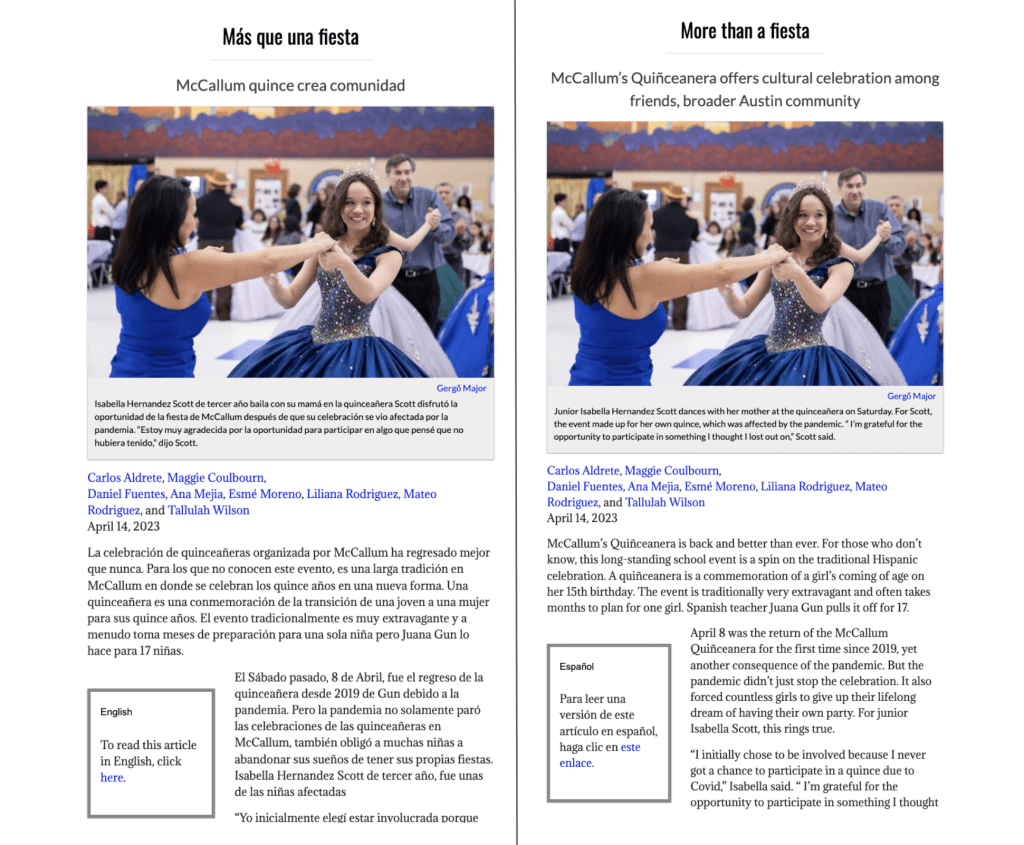 El Escudo – Online reporting
El Escudo – Online reporting
At the beginning of my junior year, the Spanish 6 class proposed the idea of translating articles for The Shield into Spanish. As the new editor-in-chief, I immediately jumped at this opportunity. I knew it would help us better provide news to McCallum’s diverse community of students. We dubbed the program El Escudo (The Shield in Spanish) and created a tab for this content on our homepage. Each article included is published in both English and Spanish, with easy navigation between translations.
Of the 1800 students on the McCallum campus, 9.2% are English Language Learners with 147 speaking Spanish at home or as their primary language. This leave a significant number of students and families with limited access to The Shield due to language barriers. Beyond that, Spanish is one of only four language courses offered at McCallum. With a foreign language graduation requirement, there is are a number of students who could benefit from more exposure to Spanish. Offering these news stories not only serves students with less proficiency in English but also offers language exposure to students looking to improve their Spanish comprehension skills — a skill that, in the state of Texas, can be invaluable.
Visit macshieldonline.com to see all El Escudo stories.
El Escudo – Print reporting
The first El Escudo story was published in our first print issue of the 2022-23 school year, but the rest were all published online. Going into the 2023-24 school year, I decided I wanted to unite The Shield and El Escudo more, so I advocated for their story on the Ballet Folklorico club to be double truck for our second issue of the year. My fellow EICs agreed, and I got to work designing the page below.
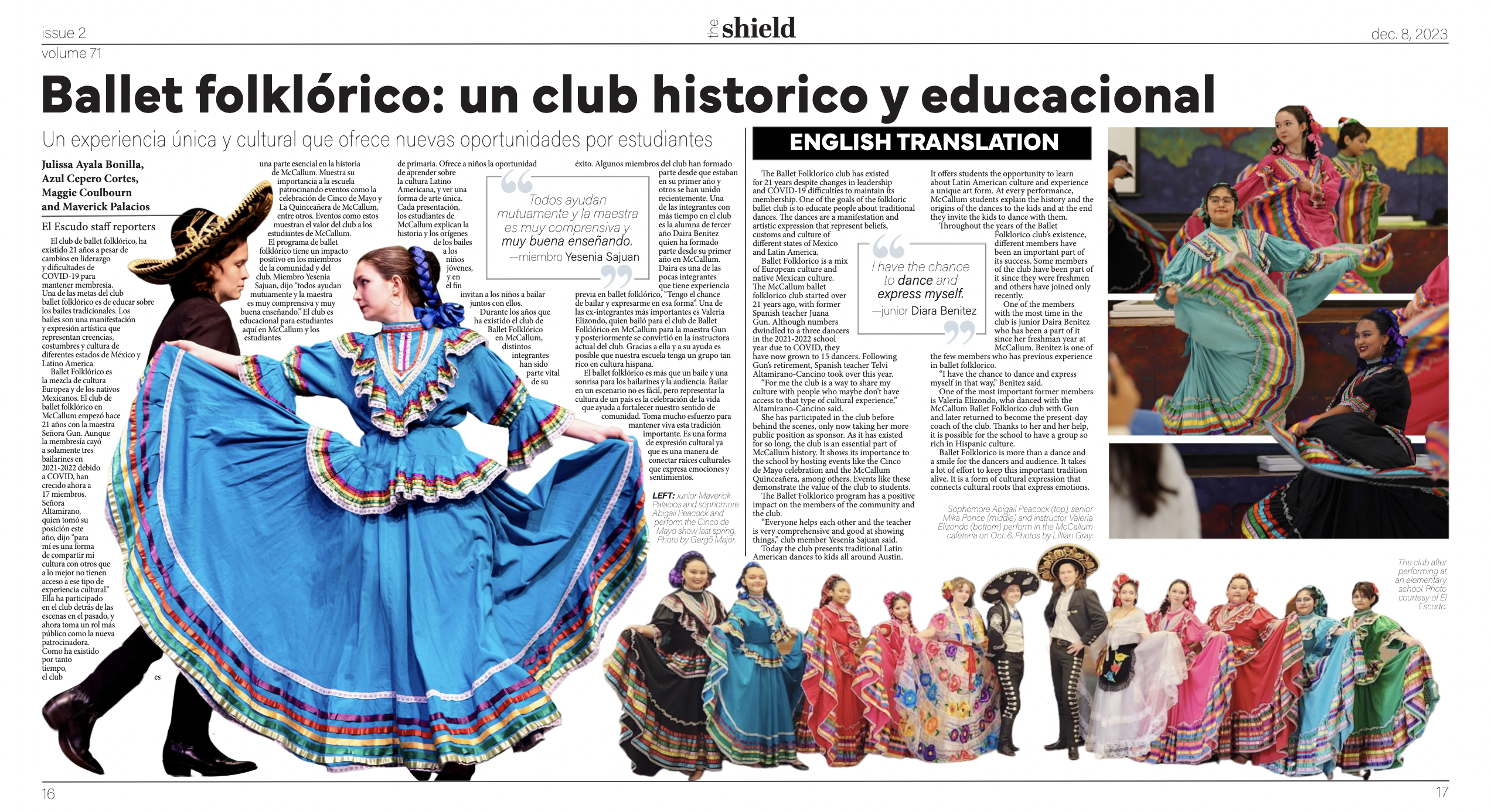
Although our website has more reach, our print issue does give students a tangible way to get news. In addition, every student is mailed a copy of the newspaper, which means that all students have some exposure to The Shield in print format. Putting an El Escudo story on the double truck helped highlight their work to students who maybe are not so likely to navigate to The Shield Online in their free time. And hopefully, students who saw this visually engaging spread and appreciated having news translated to Spanish were then able to go to our website and see all of the other content already written by El Escudo.
Recognitions: First place Newspaper/Newsmagazine Page/Spread Design – NSPA Clips and Clicks (Fall 2023)
El Escudo – Translating existing articles
Generally, when we publish an El Escudo story, the Spanish 6 team conducts their reporting and writing in Spanish, and then they go back and translate their story into English. In this way, they are not only providing news in Spanish but are also doing original reporting on people and topics that have not yet been covered by The Shield. However, after I interviewed the family of former McCallum custodian Yolanda Zertuche, who had recently passed away, I realized that there was a way for her story to have an even greater impact. I spoke with Yolanda’s family at a benefit lunch they were holding and I learned that almost all of her friends and family who were there spoke Spanish, with many family members speaking Spanish as their primary language. I wanted her family to have access to the story, so I recruited El Escudo staffers to help translate my article for its web version.
Although I knew that this story was meaningful to McCallum students and staff, the people who would be most impacted by the reporting were Yolanda’s family. By translating my article, I ensured that this article would fully reach the people it mattered to most. To read the English version of this story, navigate to Reporting & Writing.
Recognitions: Best of the Best, First runner-up – objective writing, TAJE (2023)
Storytelling
Whenever I work on a story, I always aim to find a unique angle or diverse perspective to tell it through. This is because, especially in the case of student journalists, there are certain stories that we always write year after year — homecoming, prom, graduation. The fact that these events always happen doesn’t make them less important, but it does make them challenging to tell in a way that doesn’t feel tired or overly familiar to readers. As a reporter and leader, I have worked to see these stories as opportunities to find a different, new and interesting perspectives to incorporate into our coverage. Below are just a few examples of this practice in action.
The key equals confidence
When it came time to cover McCallum’s rivalry Taco Shack Bowl this year, I felt a sense of impending doom. I knew, like most McCallum students, that the story would be no different than the story of last year’s game. Or many games before that. A heartbreaking defeat for the Knights. After learning that Ben Polega, who uses a wheelchair due to quadriplegia, had been selected as the cheer team’s mascot, I realized that there was a clear path to telling the story in a unique way. Featuring Ben’s role as the mascot was a new way to tell the story of Taco Shack. This story was an opportunity for me to showcase student excellence and to highlight a diverse voice on campus, allowing me to shift focus away from wins and losses and toward school pride.
Recognitions: First place Best of Show Broadcast News – NSPA (2023); Third place Broadcast Sports – NSPA Clips and Clicks (Fall 2023)
Voting for the first time with humanity in her heart
In the fall of 2020, The Shield produced multiple pieces on the presidential election, but most focused on voter registration and student involvement, an angle similar to our election coverage every year. While these angles localize key news stories to McCallum, they fail to tell the story in a new, unique and diverse way. So when I learned that my Spanish teacher, Telvi Altamirano Cancino, had voted in the election for the first time as a U.S. citizen, I knew I had found a unique perspective to tell a relevant national news story in a diverse way. This traditional broadcast package that included a personal interview allowed students to connect with a school community member who was part of a key demographic in the 2020 presidential election.
Recognitions: Honorable mention Video Feature package CSPA Gold Circle (2022); Part of my 4th place winning NSPA Multimedia Journalist of the Year portfolio (2021)
Black History Month door decoration reels
During the month of February, McCallum organizes a number of events to celebrate and inform students on Black History. From a student panel to a hair braiding demonstration to a presentation from a University of Texas professor, the administration and the Students of Color Alliance make sure there are a wide-range of activities throughout the month — events that have become embedded into our school traditions. This year, as I was looking at our coverage of Black History Month, it felt uncomfortably familiar. I knew covering these events in the same way as the years before was just not going to work.
Usually, we post about all of the BHM events on Instagram with photos and in-depth captions and then at the end of the month, we create a photo essay for The Shield Online that reflects on these events as a whole. While this coverage is complete, it offers nothing new to our audience. So this year, we decided to cover teacher door decorations through reels, a format with proven popularity according to our analytics. These 90-second shorts asked teachers three thoughtful questions about their BHM doors, paired with b-roll of their decorations. This short and digestible format told the story behind the door decorations and highlighted a piece of McCallum’s Black History Month celebrations in a new way. Below are three of my favorite BHM reels that I created. To see them all visit @macjournalism on Instagram.
Coverage
My approach to coverage has always been that no story — so long as it meets the basic criteria for newsworthiness — is unimportant. Even if a story is only about one person, or represents one community, the story is still valuable. One of the ways I have worked to encourage inclusive coverage is by personally telling the stories of groups within the McCallum community — no matter how big or small those groups of students may be.
King, queen and in between
During my sophomore year, the Student Council decided to eliminate gendered titles for the Homecoming Court. Instead of the female “Queen,” or male “King,” court members were simply named “Homecoming Royalty,” to be more inclusive to different gender identities and sexualities. When I wrote this story, I couldn’t help but feel pride in attending a school, that wants to support its diverse student body — even if that means making changes that go against tradition. It might seem surprising that a public high school in the middle of Texas would be able to pivot in such an inclusive way, and yet that’s just what McCallum does. This story showcases how sometimes a small group can make a big difference to impact the community at large. Covering this story encouraged me to build on the work that my school was already doing to foster diversity and inclusivity.
Recognitions: Third place News Feature SIPA Best Writing (2021); Third place News Writing Quill and Scroll Writing, Photo and Multimedia Contest (2022)
Imaginitive alum bring puppets to life
Sam’s story was brought to me by my adviser in the fall of the 2020-21 school year. A recent graduate, Sam was a familiar face to McCallum students and known for his talent of bringing familiar characters to life as hand puppets. The fact that Sam’s work was about to be showcased at Sage Studio, a gallery for artists with behavioral and developmental disabilities, gave it both timeliness and relevance to our community.
Originally, I planned to make this a video news story about Sam’s exhibition, but after interviewing him I realized there was so much more to the story and to Sam. I took the approach of a mini-documentary to tell this feature story because I wanted students on our campus to see his personality as well as his artistic efforts. In telling this story I hoped to share a side of Sam that McCallum community didn’t already know.
Recognitions: Second place Video Feature package CSPA Gold Circle (2022)
Letters to the editor
 In addition to covering all of the different groups on campus, we also offer readers the opportunity to submit letters to the editor in the case that they aren’t seeing themselves or their opinions represented in our paper. Last year, I realized that letters to the editor was a valuable area of journalism that The Shield was lacking in, so I revamped our policy over the summer when I was creating The Shield staff manual to include more clear instructions about how to submit (learn more about it in Editing, Leadership & Team building).
In addition to covering all of the different groups on campus, we also offer readers the opportunity to submit letters to the editor in the case that they aren’t seeing themselves or their opinions represented in our paper. Last year, I realized that letters to the editor was a valuable area of journalism that The Shield was lacking in, so I revamped our policy over the summer when I was creating The Shield staff manual to include more clear instructions about how to submit (learn more about it in Editing, Leadership & Team building).
This clarification of our policy paid off and in our third issue this year, we were able to include a letters to the editor page. Some of the letters offered critique, whereas others simply wanted to share their opinions on the topics we’d written about. This allowed us to include coverage of viewpoints that we may have previously missed and get our readers more involved in the work we do. This feature rounds out our coverage and makes sure we were fully representing our community
Engagements
Knowing your audience, and incorporating diverse storytelling and coverage can improve your ability to create inclusive content, but until you take your publication apart and look at who it really covers — individuals and groups — and how frequently they appear, you don’t have a good sense at how successful you are in this area.
One of the ways I have approached this is by doing “Inclusion Tracking” for our print issues. This audit tracks the sources used for each story and helps us avoid over-covering certain individuals and failing to cover others. We use this to influence what we pitch in the next issue to ensure that our coverage is truly diverse.
Click through this spreadsheet to see our inclusion tracking for the first four issues of the year. Note: Names marked in red are people who have been featured in The Shield more than once.
Unlike a publication that comes out once annually (like a yearbook), we have the opportunity to visit and revisit our strategy for including as many members of our community as possible. However, I have to acknowledge the fact that because MacJournalism and The Shield Online have a daily coverage model, it isn’t a perfect system with the sheer volume of work being put out through both platforms. The act of tracking sources in our most tangible publication helps keep inclusivity and diversity part of the conversation in everything that we do.
The work of creating an inclusive publication is not only meaningful because it helps us accurately depict our school, but also because when students see themselves represented in our publication, they are more likely to get involved with The Shield — whether that means being more open to an interview or taking an even bigger jump by signing up to join our program. Ultimately, this helps us cultivate a more diverse staff, which leads to more diverse content, continuing the cycle.
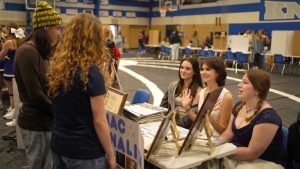
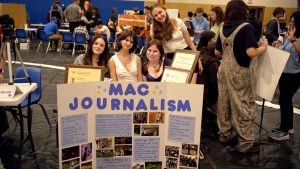 While this type of organic engagement is valuable, it’s also important to do intentional recruiting. I have volunteered at every parent back-to-school night and student expo night to help answer questions and promote our program. Attending whole-school events broadens student exposure to MacJ and limits any barriers to being part of our team. If we are going to create a publication that represents our school community, it is important that our school community is represented on our staff.
While this type of organic engagement is valuable, it’s also important to do intentional recruiting. I have volunteered at every parent back-to-school night and student expo night to help answer questions and promote our program. Attending whole-school events broadens student exposure to MacJ and limits any barriers to being part of our team. If we are going to create a publication that represents our school community, it is important that our school community is represented on our staff.
Final thoughts
In all honesty, looking at diversity as its own category is a little challenging for me because my approach has been to incorporate it into everything we do on The Shield. I don’t go in search of diversity. I look for stories that need to be told — whether that means sharing a different perspective or finding a unique angle on an ordinary story — and diversity follows naturally.
While this section showcases some of my more intentional work toward inclusivity, I hope that the work shown on every page of this portfolio demonstrates my commitment to diversity in all storytelling forms.
